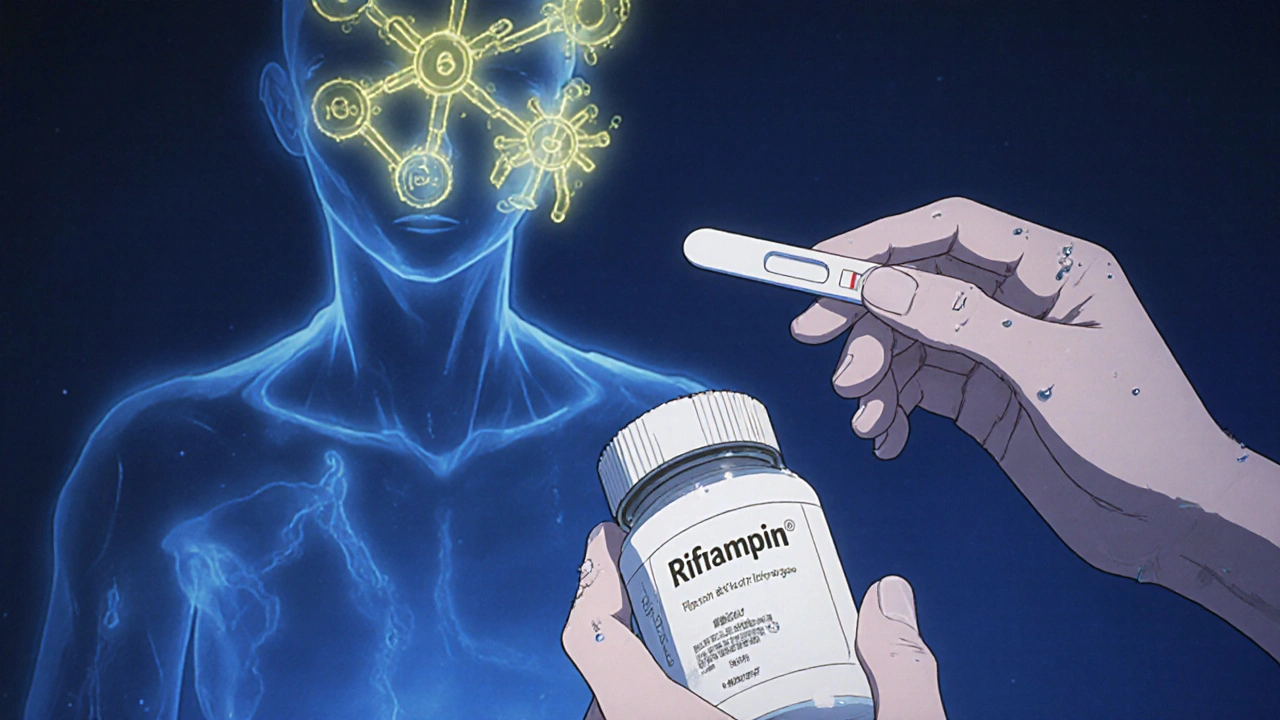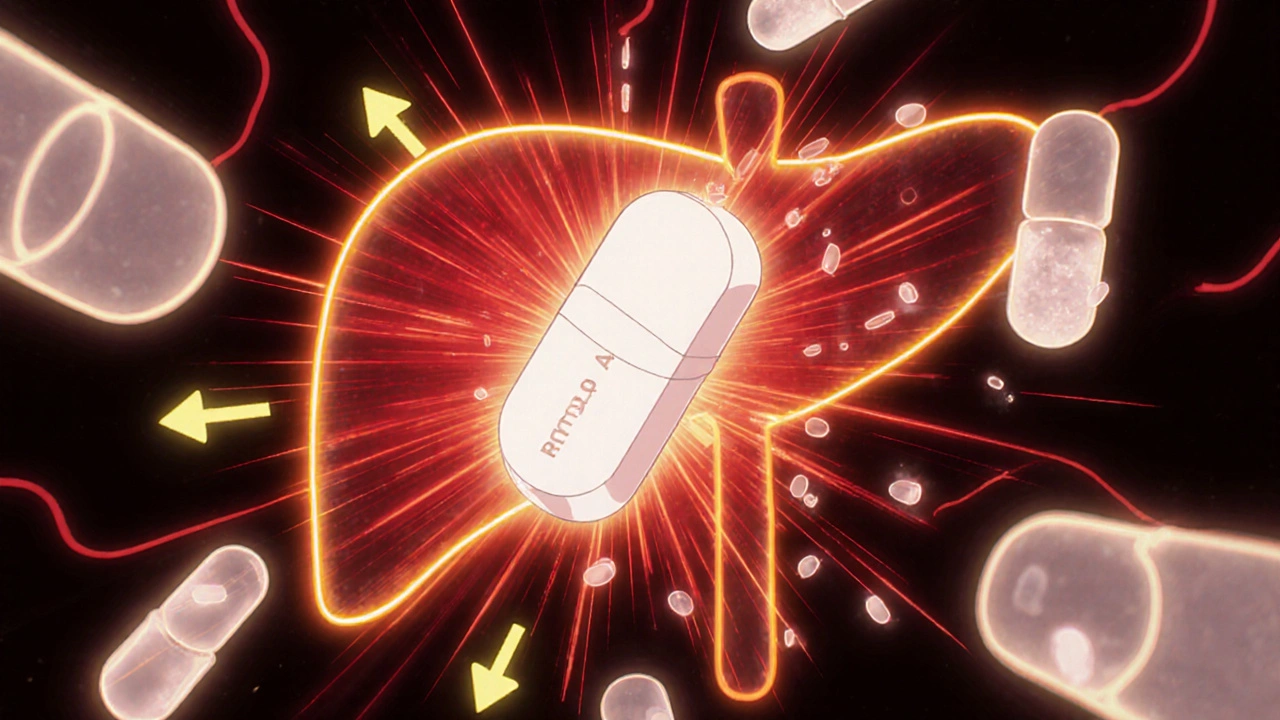Rifampin Drug Interaction Washout Calculator
Rifampin induces liver enzymes that can reduce effectiveness of other medications for 14-28 days. Enter any medication to see how long you should wait before restarting it.
When treating tuberculosis, rifampin is one of the most powerful drugs doctors have. It cuts treatment time from 18 months to just six. But here’s the catch: rifampin doesn’t just kill TB bacteria. It also messes with almost every other medication you’re taking.
How Rifampin Works - and Why It’s So Powerful
Rifampin, also called rifampicin, is a natural antibiotic derived from a soil bacterium. It was first used in the 1960s and quickly became the backbone of modern TB therapy. Its job is simple: it locks onto the RNA polymerase enzyme inside Mycobacterium tuberculosis, stopping the bacteria from making the proteins they need to survive. At just 0.1-0.5 µg/mL, it shuts down bacterial gene expression - and it doesn’t touch human cells.
After a standard 600 mg dose, blood levels peak around 7 mcg/mL. That’s enough to wipe out TB bacteria both inside and outside cells. But if you take it with food, absorption drops by 30%. That’s why it’s always recommended on an empty stomach - usually one hour before breakfast.
What makes rifampin truly unique isn’t just how well it kills TB. It’s how aggressively it changes your body’s ability to handle other drugs.
The Hidden Power: Rifampin as a Drug Metabolism Engine
Rifampin doesn’t just work on bacteria. It flips a switch in your liver and intestines - the pregnane X receptor (PXR). Once activated, this receptor tells your body to produce more of certain enzymes, especially CYP3A4. This enzyme is responsible for breaking down more than half of all prescription medications.
Within 24 hours of your first rifampin dose, CYP3A4 levels start climbing. By day 5-7, enzyme activity spikes by 200-400%. That means any drug processed by CYP3A4 gets broken down way too fast. Your body clears it before it can do its job.
This isn’t theoretical. Here’s what happens in real patients:
- Oral contraceptives lose up to 67% of their effectiveness - leading to unplanned pregnancies.
- Warfarin, a blood thinner, drops by 42% - raising the risk of dangerous clots.
- HIV protease inhibitors like ritonavir and atazanavir crash by 75-90% - risking treatment failure and drug-resistant HIV.
- Statins like simvastatin and atorvastatin become almost useless, increasing heart attack risk.
- Immunosuppressants like cyclosporine and tacrolimus can fall below safe levels, triggering organ rejection in transplant patients.
And it doesn’t stop there. Rifampin also boosts p-glycoprotein, a transporter that pushes drugs out of cells. That means even if a drug survives liver breakdown, it may never reach its target tissue.
How Long Does the Effect Last?
Many people think once they stop rifampin, the interactions stop too. Not true.
CYP3A4 enzymes have a long half-life. Even after you take your last rifampin pill, enzyme levels stay elevated for up to two weeks. That’s why doctors insist on a 14-day washout period before starting any new medication that’s sensitive to CYP3A4. For drugs with narrow therapeutic windows - like warfarin or certain anti-seizure meds - you need a full 4 weeks.
Skipping this window isn’t just risky - it’s dangerous. There are documented cases of transplant patients rejecting organs and women becoming pregnant while on birth control because they didn’t wait long enough after finishing TB treatment.

The Paradox: Rifampin Makes TB Itself More Resistant
Here’s the twist: rifampin doesn’t just interfere with your other meds - it helps the TB bacteria survive.
Research shows that within hours of exposure, even low doses of rifampin trigger a survival response in M. tuberculosis. The bacteria turn up production of a key protein called RpoB, which helps them tolerate the drug. At the same time, they activate efflux pumps - tiny molecular valves that spit rifampin back out before it can kill them.
This isn’t genetic resistance. It’s a temporary, reversible trick. The bacteria aren’t mutated - they’re just hiding. And because this happens so fast, even patients who take rifampin correctly can harbor these tolerant bugs. That’s why six months of treatment is non-negotiable. Shorter courses? Relapse rates jump above 25%.
What About Liver Damage?
Rifampin is hard on the liver. About 10-20% of people on standard TB regimens see liver enzymes rise above safe levels. That’s why doctors check ALT and AST levels every two weeks during the first two months of treatment.
The damage comes from multiple sources: oxidative stress, mitochondrial overload, and altered bile flow. In rare cases, this leads to acute liver failure. The risk goes up if you’re older, drink alcohol, or take other liver-metabolized drugs like isoniazid.
Interestingly, rifampin is also used off-label to treat severe itching in liver disease. It works by boosting CYP3A4, which helps break down bile acids. That’s why some patients with primary biliary cholangitis get relief - but it’s a double-edged sword. The same mechanism that helps itching can wreck your other meds.

Breaking the Cycle: New Strategies to Fight Rifampin’s Limits
Scientists aren’t giving up. New research is looking at how to block the bacteria’s escape routes.
One promising idea: repurpose common drugs to shut down those efflux pumps. Verapamil - a heart medication - and omeprazole - a common acid reducer - have been shown to block rifampin expulsion from TB bacteria. In lab studies, omeprazole reduced efflux by 68% at normal clinical doses.
That’s huge. If these drugs can be safely added to TB regimens, they might cut treatment time from six months to three. Clinical trials are already underway. Early animal data shows relapse rates dropping from 25% to under 5%.
Another approach? Higher rifampin doses. Some trials are testing 900 mg daily instead of 600 mg. That boosts drug exposure by 74% - but it also increases enzyme induction by 35%. It’s a trade-off. More killing power, but even more drug interactions.
What You Need to Do - Practical Steps
If you’re on rifampin, here’s what you must do:
- Make a full list of every medication, supplement, and herb you take - including birth control, vitamins, and over-the-counter painkillers.
- Give this list to your TB doctor and pharmacist. Don’t assume they know what you’re on.
- Ask: "Is this drug broken down by CYP3A4?" If yes, it’s probably affected.
- Never start or stop any new drug without checking with your TB team.
- Use backup birth control - condoms or an IUD - during and for two weeks after rifampin.
- Report yellow skin, dark urine, or severe fatigue immediately - signs of liver trouble.
- Don’t skip doses. Even one missed pill can let tolerant bacteria regrow.
And if you’re finishing rifampin? Wait. Don’t rush. Two weeks minimum before starting anything new. Four weeks if it’s something critical like warfarin or an anti-rejection drug.
Why This Matters Beyond TB
Rifampin is a global health cornerstone. Around 3.5 million people start TB treatment with it every year. But because of its interactions, it’s also one of the most dangerous drugs in common use.
Understanding rifampin isn’t just about treating TB. It’s about understanding how one drug can reshape your entire body’s chemistry. It’s a reminder that powerful medicines don’t work in isolation. They rewrite the rules - and you need to know the new ones.
Can I take birth control while on rifampin?
No, standard hormonal birth control pills, patches, or rings become 67% less effective when taken with rifampin. You must use a non-hormonal method like condoms, a copper IUD, or a diaphragm during treatment and for at least two weeks after stopping rifampin. Relying on hormonal contraception alone can lead to unintended pregnancy.
How long after stopping rifampin can I start another medication?
Wait at least 14 days before starting most new drugs. For medications with narrow therapeutic windows - like warfarin, cyclosporine, or certain seizure drugs - wait 28 days. This allows your liver enzymes to return to normal. Starting too soon can lead to underdosing and treatment failure.
Does rifampin interact with over-the-counter drugs?
Yes. Common OTC drugs like St. John’s wort, certain antacids, and even some cold medicines can interfere. St. John’s wort also induces CYP3A4, making rifampin’s effects worse. Antacids can reduce rifampin absorption if taken too close together - space them at least 2 hours apart. Always check with your pharmacist before taking anything new.
Can I drink alcohol while taking rifampin?
It’s best to avoid alcohol. Both rifampin and alcohol stress the liver. Together, they raise your risk of drug-induced liver injury. Even moderate drinking can push liver enzymes into dangerous territory. If you drink regularly, your doctor may need to monitor your liver function more closely or adjust your treatment plan.
Are there alternatives to rifampin for TB treatment?
For drug-sensitive TB, no - rifampin is irreplaceable. It’s the only drug that can shorten treatment to six months. For drug-resistant TB, other drugs like bedaquiline or delamanid are used, but they’re more expensive, less available, and often have worse side effects. Rifampin remains the gold standard because it’s effective, affordable, and widely accessible.
Why is TB treatment so long if rifampin kills bacteria so fast?
Even though rifampin kills most TB bacteria quickly, a small group enters a dormant, tolerant state within hours of exposure. These bacteria aren’t resistant - they’re just hiding. They don’t multiply, so antibiotics can’t kill them. Only long-term treatment (6 months) ensures all of them are wiped out. Shorter courses lead to relapse in over a quarter of patients.


Graham Holborn
Hi, I'm Caspian Osterholm, a pharmaceutical expert with a passion for writing about medication and diseases. Through years of experience in the industry, I've developed a comprehensive understanding of various medications and their impact on health. I enjoy researching and sharing my knowledge with others, aiming to inform and educate people on the importance of pharmaceuticals in managing and treating different health conditions. My ultimate goal is to help people make informed decisions about their health and well-being.